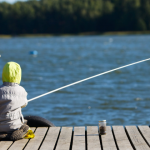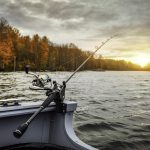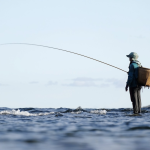
Muskellunge make for a great eating fresh water catch, but although they can be found throughout Michigan, Wisconsin, Minnesota, and the Great Lakes region, they are not an easy fish to catch; making them a prize for anglers when they finally manage to hook them. Because they have been introduced into the Mane area and are threatening local trout supplies, there is no catch and release policy and no minimum size for them, if you catch one, you keep it — but there are people who disagree with this policy, and in other areas there is often a catch and release in place, so check in with local experts before you cast.
Muskies are a non-native species of pike fish that can get pretty aggressive when they want to, and when some can grow up to 6ft long, when they want to be aggressive you will have quite a fight on your hands to catch one. Thus, if you are wanting to try your hand you probably want to get some Musky Gear info from http://www.tackle.org, so you know what setup is going to help you win the fight.
Are Muskies Good For Beginner Anglers?
You have heard of beginner’s luck? This catch might be just the thing to test this theory, they are called the “the fish of ten thousand casts”, which might give you a bit of a hint as to what you could be in for. They are a notoriously difficult fish to get to take a nibble on your hook, but they are a heavy fish, very strong, and aggressive, so you need to make sure that if you are heading out to a Musky area, then you are prepared to catch one.
Of course, there is probably a better likelihood that Bass or Trout will end up on your line, proving that the excitement never ends on a freshwater fishing expedition.

Timing Is Everything
Although Musky’s make a lovely dinner, for many people the size and difficulty of catch make them a highly desirable trophy fish. If you are looking for something to get mounted and displayed then you cannot beat this beautiful, and big, freshwater fish. Although they technically can, of course, be caught at anytime of the year, most trophy hunters tend to head out around September and October to catch the fish as they are putting on fat to get them through winter.
These creatures are definitely affected by changes in temperature and you will find them in different depths depending on the time of year. You will also find them more active at different times of the day throughout the year, depending on how warm the weather is. And then there is the effect the moon has on Muskies. Although, all experienced anglers have theories about when is the best time to catch any sort of fish, relating to time of day, phase of the moon or weather conditions, a lot will depend on the type of fish being sought after and the location of the fishing spot.
However, with muskellunge there has actually been some research into the effectiveness of a catch based around moon phases, and it seems that there is some truth to the idea that you will increase your chances of catching one of the prize fish if you head out during a full or new moon. https://www.scienceopen.com/document/read?vid=2de9fe23-80bb-4d2c-b968-654752afed56
If you are off to a new area your best bet is going to be to nip into your friendly fishing store on the way and get some advice for the best spot to head to and the best timing to aim for. With luck you will be in the right spot at the right time to get yourself a big one.

What Is The Best Tackle?
This can possibly be one of the biggest causes for arguments for anglers that are going after the big trophy Muskies, but one thing you will find that they generally agree on is that a cheap and weak setup is only going to cause you heartache, as it breaks and ends up in the water, while your catch swims away smirking at you. However, you should check local regulations for rules around catch and release to make sure that you are going to be able to comply with whichever setup you use (see here).
Of course, most expensive does not always equate to being best, what you need to ensure is that you are investing in a rod that is going to be strong enough to hold up to the weight of a big fish, as well as being flexible enough to cope with the fight of a really aggressive fish that is going to want to get off your line — if it takes your whole setup with it, even better.
You will absolutely need a strong rod, and most prefer a longer rod of at least 8ft, generally a heavy action (although medium might do you if you do not land anything too big), and you will usually find that a graphite composite rod is going to have less chance of breaking than the fiberglass rods. You can buy rods that a specifically built to help you make the most out of your one of the most of your 10,000 casts.
However, one of the most important aspects to catching this fish is likely to be your reel. Getting the ratio right can be tricky, and this is where you are best to read the reviews and take the advice of those who have gone before you and trust people who have actually pictured themselves with a Musky, so that you know they have at least some idea of what it is like to catch on! High gear reels are going to give you a bit more speed when you are pulling in your catch, while a lower power is going to give you a bit more control. Reading the reviews for different reels while help you decide, which is going to provide a smoother line, so you do not run the risk of either tangled line causing breakage or jerking line giving your fish the perfect opportunity to get the hook out.







